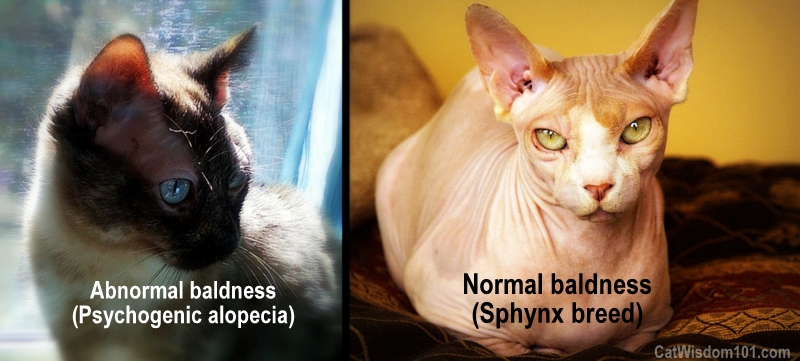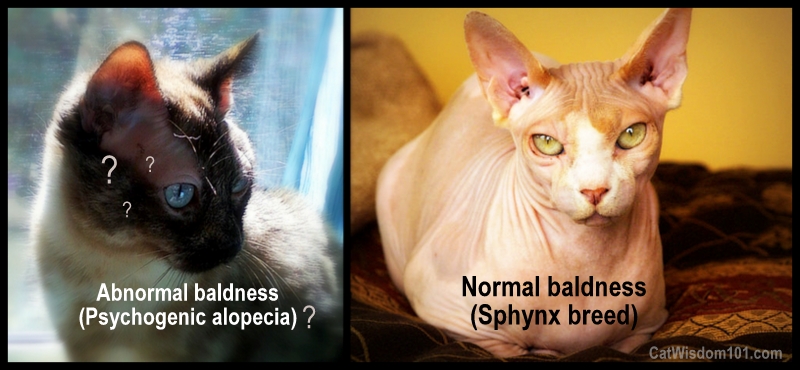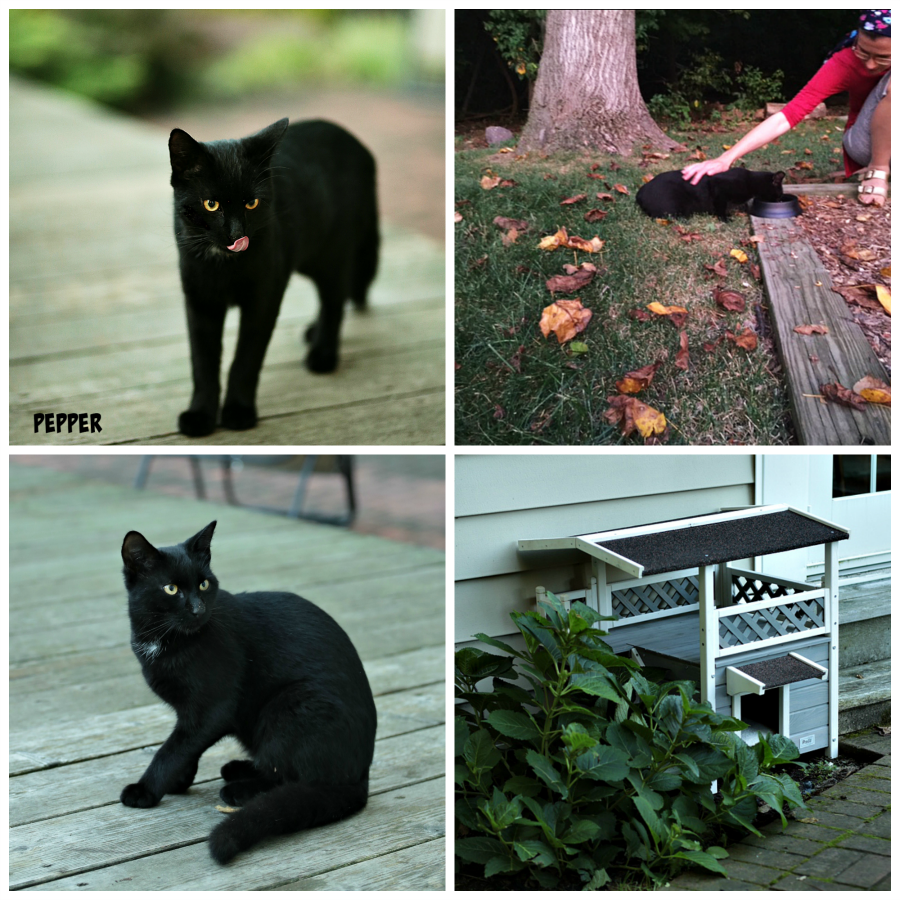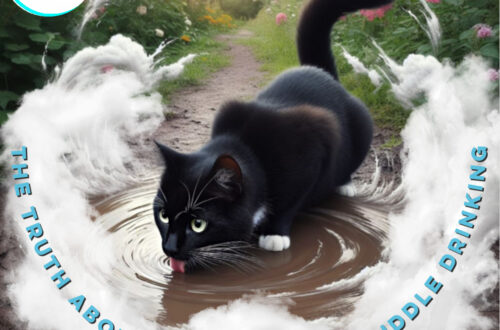
Vet 101: Decoding Feline Baldness

Today’s Vet 101 is a prime example how complicated making a diagnosis can be. In most states a vet cannot legally make a diagnosis online. Sometimes even the best vet can be stumped by a myriad of symptoms and a second opinion or two is warranted. One Vet 101 reader submitted an intriguing situation involving a physical condition and behavioral issues. Dr. Letrisa Miller DVM offers several angles of looking at the situation. We went back and forth with several email exchanges to take this reader question to a deeper layer. While insightful, I hope it demonstrates how important it is not to rely solely on online advice and to seek an in-person veterinary consultation. I’ve made holistic behavioral suggestions not addressed in this response and was impressed with this cat guardian’s dedication and patience with a challenging condition of her much loved cat.
Vet 101: reader Q & A
Q: (Edited). MMM is a high strung seven-year-old, part Siamese, semi-feral female adopted three years ago and spayed at that time. She adjusted to a new cat mom and is affectionate with her and one of three other cats but continues to show aggression to the other two. There were many cat fights. In Oct. J bit MMM and they’ve been separated since. About two years ago, MMM removed her temple fur and she was on prednisone, which helped. She was checked for allergies, and had scrapings for parasites. Her fur started to grow back. A little over a year ago. MMM started her hair removal again. We tried the prednisone without any affect, I’ve tried pheromones, calming collars, treats, drops, Spirit Essences, everything 2 vets and I could think of. Nothing worked.In April MMM was put on Prozac (the vet said it was OCD). First the first time I felt like we were on the right track. She stopped obsessing about from under the door and she stopped hissing at C. Now that she isn’t antagonizing him, he stopped chasing her, but she is still going at her fur.We decided to try a tranquilizer, hoping she would relax enough to leave her fur alone. And it worked for a couple days, but she was still fussing with her temples, so I put a soft collar on her. I’m hoping the scabs will heal and the behavior will stop. Currently she is on Acepromazine 2.5 mg twice a day & 5 mg Prozac once a day. Any help appreciated.
The easiest way to accomplish the test is to feed a hydrolyzed protein diet (Royal Canin is my favorite) for a minimum of eight weeks—a 12-to-16-week test is best—to determine whether the symptoms resolve. The hard part of the test is giving the cat enough time to ensure that all nonhydrolized protein sources have been eliminated from the body. Eating even a single piece of food that is not made of hydrolyzed protein can invalidate the test, requiring the timer to be reset. Despite the time commitment (and the cost: hydrolyzed diets are difficult to manufacture and are thus very expensive), the result is worth it. No cat wants to suffer from allergies, and most human beings are more than happy see an end to their cat’s symptoms, be they alopecia, constant itching, vomiting, or all of the above.
Tamed Feral Cats
When dealing with tamed feral cats, please always remember that they are wild animals first and domestic cats second. Most cats that have a feral kittenhood without human socialization will always have some level anxiety in our households. They are prey animals, and they know it. This makes them jumpy and suspicious of large animals like humans that could eat them. (You won’t eat a cat and I won’t eat a cat, but the cat can never be sure of that.)
Household Stress
Different cats handle stress in different ways. Some hide and won’t come out; others get angry and find someone to take their frustrations out on. I often think of human toddlers when trying to understand what cats are doing and why. The similarities are numerous.
When frustrated they either turn inward and withdraw or they get angry and act out. Often the acting out is not logical or directed at the source of the frustration. When the frustrated critter, human or cat, doesn’t feel well for any reason, the problem escalates. One way to think of the situation is if you have a headache and have no way of talking. A loved one starts making noise near you. You have the options of putting up with it even though it makes your head hurt worse (withdrawal), leaving (withdrawal), or getting angry and lashing out. Cats respond similarly, so a cat that has been getting along well with a housemate may suddenly start attacking when it doesn’t feel well. The emotional release gained from the attack may be satisfying to the cat and over time could become a habit or conditioned response.
One way to try to break a conditioned response is to interpose yourself between the cats and redirect behaviors. If you are in a room with the aggressor cat (Jill) and the attacked cat (Jack) comes into the room, say to Jill, “Look here’s Jack,” and give Jill the thing she likes best to redirect her attention to something positive that also makes her look away from Jack. The reward could be playing with a toy, a scratch under the chin, or a piece of really yummy food.
The important thing is that she must know that Jack has come into the room and her attention must get directed away from him. After a few weeks of doing this every time Jack comes into the room, she will become conditioned to look away and have a positive feeling or expectation. This sort of training can take up to 12 weeks, so persistence is important.
Another way to help break the cycle, although it is a more negative response, is to use “time-out.” Time-out is putting the aggressor cat in a less-desirable space such as a kennel or small room and closing a solid door so that it cannot see what is going on in the rest of the house. The punishment should last for only two-to-three minutes, and the cat should simply be picked up (if you can do so safely) and put into time-out at the first sign of aggression (often a stare). Don’t speak harshly or behave aggressively or in any way involve emotion in the punishment. The goal is to get the cat to associate an effect it doesn’t like (time-out) with a particular cause (aggressive behavior) and thus to start behaving in a new way in order to avoid the undesired result. If you insert your own anger or aggression in the punishment, it will only fuel more anger and aggression from the cat.
Time-out and positively reinforced redirection work well together in my experience. Improvements in behavior are often seen in a few days to a few weeks. Sometimes, though, the behavior gets worse just before going away, so don’t give up!
Cats That Hate Each Other
Cats that hate each other—particularly females—rarely become friends. Female cats are highly territorial and will rarely accept other female cats into their core areas if they are not related or known from kittenhood. Even when introductions are done in a gradual, stepwise manner, some cats just don’t like each other. Think of this like the college roommate lottery. You may get a roomy with whom you love to spend time, but you are just as likely to get one whom you would love to lock out of the room forever.
When we present opinionated cats with new housemates, this can spell disaster. We didn’t ask their opinion first, so we really shouldn’t blame them for not getting along as nicely as we imagine they should. Unfortunately, in some cases the only option is to keep the cats separated. Sometimes by providing separate core areas (see my earlier blog post “Nine Behavior Lessons”), you can bring about a ceasefire, but negotiating a truce can be hard, and it may fall apart at any time. Even littermates who have loved each other for a lifetime can have a single falling out and never be friends again.
Some great websites with more information about introducing cats are:
http://www.fabcats.org/behaviour/introducing/info.html
http://www.humanesociety.org/animals/cats/tips/introducing—new—cat.html
Letrisa Miller
THE PETTIE AWARD NOMINATIONS – THANKS TO EVERYONE WHO IS VOTING FOR US: WWW.CATWISDOM101.COM DAILY

- Please vote for as many blogs or categories as you like including Best Cat Blog, Best Over All Blog and Best Designed Blog etc.
- For Best Video, may we recommend our Vet 101 video how to give a cat exam at home
- For Best Blog Post may we recommend our post on cats growing older





15 Comments
Brian
Thanks for that article this is useful. along with your complete thoughts you might have inspired me to start out making Thanks a lot!
Kitties Blue
I hadn’t read this post originally, but then read that MMM was doing better based on it. I found it very informative as we do have some domestic disputes among our resident kitties and the methods described here are things we have never tried and to which I am going to give serious consideration. Thanks so much for this post. Janet
Skeeter and Izzy
Thank you both for providing and sharing such great information. My Izzy has food allergies and | know how that can upset the apple cart. We truly hope that is MMM’s problem and can be solved mostly by diet. I know with Izzy if she has eaten some of Skeeters food and it has upset the digestion that she gets more agressive etc. This is usually the first sign that she has ate more than just a pinch of his food. I hate for anyone,feline,human or other animal to have to be on meds long term due to the potential for harmful side effects. We are purring that it is allergy related and can be identified and food changed and that all the meds go away. I have allergies myself and I know that they impact my whole being and I know what is wrong so I hope dear MMM gets better and that the relief eliminates the stress and anxiety and the aggression. We send our Purrs to you MMM!!! Luvs Skeeter and Izzy and the Feral Gang >^..^<
CATachresis
Sort of like Pavlov’s cat with the Jack and Jill ploy! 🙂 Once again some excellent info and much to take in. Austin has a patch over his right eye which could be the beginnings of baldness, but it could be from when he went a bit crazy the other day and knocked things over!
Oui Oui
What a thoughtful and informative post! This gives us a lot to work with and we are going to try to implement some of the measures now. Thank you, Layla and Dr. Miller! You both put a lot of deliberation and time into this. Our poor MMM would thank you too if she could. I never thought of cats as toddlers, putting them into time out or redirecting them with treats. This could work for many more problems than just our own. I’ll be checking the websites too. Purrs and thanks again!
Layla Morgan Wilde
You are so welcome. We’ll be in touch.
Brian
WOW! I sure learned a lot for this post, great info fur sure!
Sue Brandes
Thank you for the great information.
Kathryn
Lots of good info and explains when we had female cats and dogs – the Siamese girl would try to run the little Lakeland out of the house. We had to keep them on different floors of the house.
My Ched used to pick his fur because his brother was dominant and was beating up on Ched, to show his dominance. Ched felt bad and bit his tummy fur off. Over two years, I rubbed Ched’s belly a lot to make him feel loved and he finally stopped biting his belly fur off.
The Island Cats
Wow, what great info. I’m hoping this helps the situation with MMM. And I, too , have 2 cats that do not get along. I have tried everything to remedy the situation. The Jack and Jill method is particularly interesting and I will try that.
Island Cats’ mom
meowmeowmans
Wow, what a great and informative answer to a very tricky question. We sure hope this gives MMM’s mom some things to try — and we hope they are successful!
Tamago
That is great information! I love the Jack and Jill method to redirect attention.
da tabbies o trout towne
another grate post guys N we reeeeeeeeeeeeeeely hope mica can find sum help with her scratcheez…..
Katie and Coccolino
That was so informative, how interesting.
Hope you’re doing well!
Piggy kisses,
Katie and Coccolino the mini pig
Caren Gittleman
this was chock full of super good info. I need to share the last part with a friend who is having MAJOR issues with her cats not liking one of her cats which I think is causing her constant skin issues.